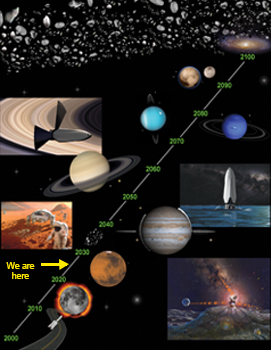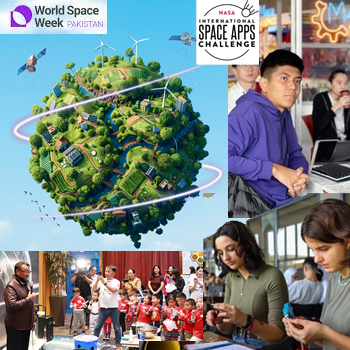21st Century Solar System Complete and
|
MONDAY☆ Sep 30 — International Space Station, ~415-km LEO: Expedition 71 Astronauts and Boeing Starliner CST-100 crew are brought new science investigations with planned arrival of Crew-9, Nick Hague and Aleksandr Gorbunov, including studies of heart muscle atrophy, plant growth, gene editing mechanisms, neurodegenerative pharmaceuticals and heatless welding. ☆ Sep 30 — Tiangong Space Station, ~390-km LEO: Of a maximum occupation of six, 3 Taikonauts onboard continue to be Commander Ye Guangfu, Li Cong and Li Guansu, enjoying foods such as ‘Space Mooncakes’ with lotus paste, spicy lamb and braised pork chops. o Sep 30 — International Astronautical Federation, Italian Space Agency, Italian Association of Aeronautics and Astronautics, Leonardo Space, et al, Online: Registration Due for Technical Tours at 75th International Astronautical Congress; to be held Oct 14-18. ★ Sep 30 — Parker Solar Probe, Heliocentric Orbit: Spacecraft reaches 21st perihelion today. ☆ Sep 30 — Apollo Asteroid 2024 SC: Near-Earth Flyby (0.010 AU) Ongoing… ● Sep 4 – Nov 25 — NASA, Online: Lunar Navigation Challenge; ahead of Artemis mission, 2 prizes available for orienteering aid and mapping bottom of Shackleton Crater. ● Sep 24 – Oct 10 — American Institute of Aeronautics & Astronautics, Online: Isotope Geochemistry and Cosmochemistry Workshop. TUESDAY☆ Oct 1 — Deep Space, Jupiter Trajectory: ESA Jupiter Icy Moons Explorer (JUICE) spacecraft now 0.96 AU from Sun with accumulated distance of 1,336,937,857 km, science instruments confirm Earth is habitable, planning to fly by Venus and Earth next year. |
 |
● = Terrestrial and… o = International terrestrial events
☾ = Moon activity ★ = Space and… ☆ = International space / astro events; in Hawaii Standard Time unless noted. Add 10 hours to obtain UT (‘Universal Time’). |
Weekly Planet Watch – Evening Planets: Venus (WSW), Mars (ENE), Jupiter (ENE), Saturn (SE), Uranus (N), Neptune (E).
World Space Week and “Hackathon” Show Humanity Working Together
Observed globally, both events seek to engage youth / students in forwarding human presence in space. World Space Week Association (WSWA) mission is “to strengthen the link between space and society through public education, participation and dialogue on the future of space activity.” World Space Week first theme was “The Space Millennium Begins” after a 1999 UN declaration to hold it in honor of October 4, 1957 launch of Sputnik 1 and October 10, 1967 signing of the Peaceful Uses of Space treaty. WSWA National Coordinators are listed for 68 countries with ~83 expected, encompassing ~16,000 events. The NASA International Space Apps Challenge, October 5-6, called the “largest annual global hackathon,” expects 280,000+ registrations / 2,400+ local events in 185+ countries / territories, 13 space agency partners including those of EU, Japan, India, Canada, Australia, Brazil, Italy, Mexico, Argentina, Turkey, South Africa, Paraguay. Invited are “coders, scientists, designers, storytellers, makers, technologists and innovators” of “all ages, skill levels and professional backgrounds”. Part of NASA Open Government Initiative to share data, participants are given tasks by NASA Subject Matter Experts, varied in complexity, ranging from visualizations of NASA data to developing apps / software, and this year asked to incorporate the idea of the influence of our Sun. This year’s theme is “The Sun Touches Everything.” Ten Global Awards are given. (Image credits: WSWA, NASA / Space Apps Challenge) |
★ Oct 1 — SpaceX, Launch Falcon 9 / Starlink Group 10-10, Cape Canaveral SFS FL: Falcon 9 to launch next batch of Starlink v2-mini satellites to LEO for space-based internet communication system. ● Oct 1 — American Astronautical Society (AAS), Huntsville AL: Student Poster Contest abstracts due for AAS 2024 von Braun Space Exploration Symposium. ● Oct 1 — National Aeronautics and Space Administration (NASA) 66th Observation, USA Nationwide: Celebrations and educational events occur to observe NACA (National Advisory Committee for Aeronautics) becoming NASA on this day in 1958. ● Oct 1 — American Institute of Aeronautics and Astronautics, Washington DC: 2024 Yvonne C. Brill Lecture In Aerospace Engineering & Reception, biennial lecture with Penina Axelrad; National Academy of Engineering, 11:00-14:00 EDT. ☆ Oct 1 — Apollo Asteroid 2024 RN15: Near-Earth Flyby (0.021 AU) WEDNESDAY☾ Oct 2 — Moon: New Moon, 08:49; at apogee (distance 406,543 km), 10:00; 1.59° SSW of Mercury, 13:00. ☆ Oct 2 — Sun: Annular eclipse of Sun, 08:49. ☆ Oct 2 — Apollo Asteroid 2024 RO2: Near-Earth Flyby (0.010 AU) THURSDAY☾ Oct 3 — Moon: 0.49° NE of Spica, 14:00. FRIDAY★ Oct 4 — United Launch Alliance, Launch Vulcan VC2S / Certification Flight 2, SLC-41, Cape Canaveral SFS FL: Second Vulcan test launch with inert payload, experiments, and demonstrations for certification with USSF, 06:00 EDT.
|
★ Oct 4 — SpaceX, Launch Falcon 9 / Starlink Group 6-61, Cape Canaveral SFS FL: Falcon 9 to launch next batch of Starlink v2-mini satellites to LEO for internet communication system.
● Oct 4 — The Space Show, Online / Las Vegas NV: Dr. David Livingston hosts Sara Seager, astrophysicist and planetary scientist.
o Oct 4-10 — World Space Week Association, Global: World Space Week 2024; to celebrate international contributions of space science and technology to the betterment of the human condition; Oct 4 is 67th observation of 1st Space mission Sputnik One launched by Soviet Union 1957; Oct 10 is 57th observation of Outer Space Treaty going into effect 1967.
SATURDAY
● Oct 5-6 — NASA and space agencies of Australia, Bahrain, Brazil, Canada, Europe, India, Italy, Japan, Mexico, Paraguay, Saudi Arabia, South Africa, Spain and Turkey, In person and Online: Space Apps Challenge 2024 (13th annual); 48-hour hackathon in French and English for space enthusiasts, programmers, designers, engineers, entrepreneurs and students.
☾ Oct 5 — Moon: 2.81° SSW of Venus, 09:00.
☆ Oct 5 — Apollo Asteroid 2024 RJ32: Near-Earth Flyby (0.019 AU)
SUNDAY
● Oct 6-10 — American Astronomical Society Division of Planetary Sciences, Boise ID: AAS DPS 2024 Meeting.
☆ Oct 6 — Apollo Asteroid 2022 SU21: Near-Earth Flyby (0.044 AU)

